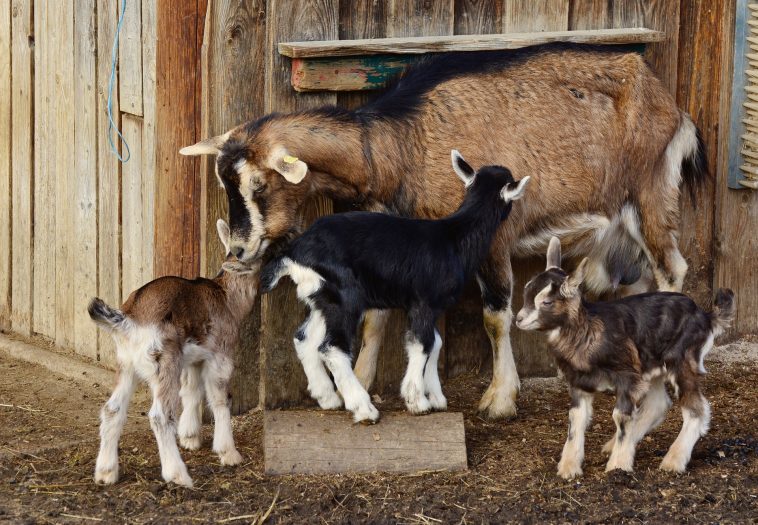Goats are one of the oldest domesticated animal species in the world and have been used for centuries for their meat, milk, and fibre.
In recent years, the popularity of goat meat has grown exponentially, and with it, the number of different meat goat breeds. While there are many breeds of goats, some are better suited for meat production than others.
Boer goat
The Boer goat is an incredibly versatile breed of goat that is highly sought after for its meat, milk, and hide production.
They are known for their resistance to disease, with a low incidence of common goat diseases such as pneumonia and enterotoxemia.
The Boer goat is a large, sturdy animal with a white body and distinctive brown head. Boer goats are known for their high fertility rates and fast growth, with rams reaching up to 135 kilogrammes and does up to 100 kilogrammes. They have excellent meat quality, with a high fat content and a mild, sweet flavour and high milk production, with does producing up to eight litres of milk per day.

Boer goats are also valued for their hides, which are used to make leather goods. The hides are highly sought after for their durability and strength, making them ideal for a variety of leatherworking projects. Boer goat hides are also known for their beautiful colouring, with a variety of shades ranging from white to brown to black.
This breed has horns, lopped ears, and a variety of colours. As a result of its browsing ability and low impact on grass cover, the Boer goat is being used very successfully in South Africa in conjunction with cattle. The ewes do not need pampering and can produce enough milk to raise kids that mature early and have a weaning rate of over 160%.
Exceptional members of this breed can gain more than 200 g per day in the feedlot, although a daily growth rate of 150 to 170 g is more typical. The ovulation rate for Boer goats ranges from one to four eggs per ewe, with an average of 1,7.
The average rate of kidding is 200%. There is a rapid maturation rate, occurring in rams at around six months and does at around ten to twelve months. Furthermore, the Boer goat has a long breeding season, allowing for three pregnancies every two years.

A strong and muscular Boer goat ram. (Source: langkloofgamefarm.co.za)
Kalahari goat
The Kalahari goat is a hardy, dual-purpose breed of goat that originated in the Kalahari desert in Southern Africa. The Kalahari goat is a medium-sized animal, with a short, glossy coat that is usually white or light brown in color. The breed is known for its hardiness and adaptability, which makes it well-suited to a variety of climates and environments.
The Kalahari goat is an excellent choice for small-scale farmers looking for a hardy and productive breed of goat. The breed has a high fertility rate, with does producing up to three kids per year. It is known for its excellent mothering ability, being very protective of its young.
Does can produce up to two litres of milk per day, making them an excellent choice for small-scale dairy operations. The milk is high in butterfat and protein, making it ideal for cheese and yoghurt production.

A Kalahari Red goat doe with her lamb. (Source: vleissentraal.co.za)
The breed has good meat quality, with lean, mild-flavoured meat that is highly sought after by consumers.
The red colour of Kalahari Red goats’ coats is their most distinguishing physical feature. Animals that are white or very light red are not desirable because they are easier to spot by predators in their natural environments. They have developed protective herding instincts. The Kalahari Red is distinguished by its long, flappy ears. There are small, sloping horns on top of their heads, just above the ears. Rams can weigh up to 115 kilogrammes, while does can weigh up to 75 kilogrammes; their build is similar to the well-liked South African Boer goat.

A Kalahari Red ram that is well muscled and stands strong. (Source: vleissentraal.co.za)
If you are looking to improve the resilience and meat production of your goat herd, Kalahari Reds make a great crossbreed. Rams should be physically larger than does, and their neck skin should be looser.
Savannah goat
The Savannah goat is a unique breed of goat that is known for its hardiness and adaptability. It is a medium-sized goat with a short, thick coat and a long, straight face. The Savannah goat is a hardy breed, able to survive in a variety of climates and environments. It is also a very productive breed, producing high-quality meat and milk rich in butterfat and protein.
The Savannah goat was bred in South Africa in the late 1950s by Cilliers and Sons, near the Vaal River, by crossing several breeds of goats. The most common breeds used in the development of the Savannah goat are Spanish, Angora, and Nubian goats. The Savannah goat was bred to be a hardy and productive breed, and it has proved to be just that.

A Savannah goat doe with her three lambs, all of which are completely white. (Source: agriorbit.com)
The Savanna goat is prized for its meat because it is a large, muscular breed. In most cases, their coats will be white because that colour is the result of a dominant allele. However, they have black pigmentation on their skin, horns, and hooves for protection from the sun.
Savanna goats are known for their high rates of fertility, mothering ability, milk production, twin births, and overall healthy offspring development. Rams can weigh up to 90 kilogrammes, while does can weigh up to 60 kilogrammes.

A Savannah goat ram that has a long, straight face. (Source: goatfarmers.com)
References
Goat Farming in South Africa (2022). Available at: https://southafrica.co.za/goat-breeds-in-south-africa.html
Breeds of Livestock, Department of Animal Science (1996). Available at: http://afs.okstate.edu/breeds/goats









